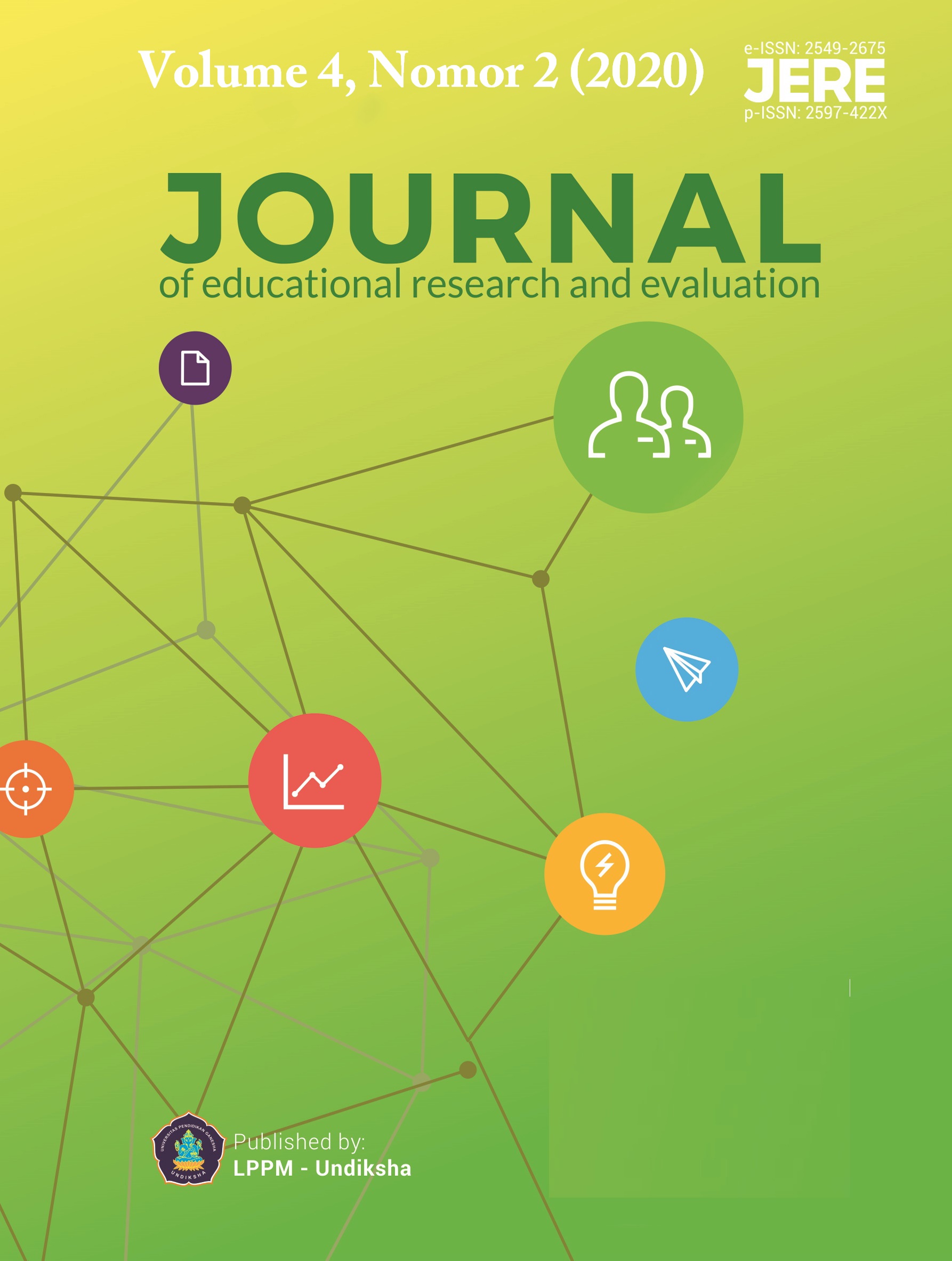Verbal Interactions in EFL at The Senior Vocational High School
DOI:
https://doi.org/10.23887/jere.v4i2.24899Keywords:
speech acts, locutionary acts, illocutionary acts, perlocutionary actsAbstract
This study was focused on identifying, classifying and understanding speech acts produced by teachers and tenth-grade students of Senior Vocational High School. The study was focused on locutionary acts, illocutionary acts, and perlocutionary produced during the EFL learning process under the theory of Austin (1962) and the theory of Searle (1969). Descriptive Qualitative design was employed in this study. Two teachers and sixty students of SMK Negeri 3 Singaraja were chosen as the sample in this study. The data were gathered through observation assisted by video recorder. The data were analyzed descriptive-qualitatively. The result of the study showed that the teachers produced all types of speech acts, namely directive, commisive, expressive, declarative and assertive. The most dominant type produced was directive act in form of requesting. It was used to ask the students for doing something and giving instruction. The other types of speech acts were not dominant. Meanwhile, the students produced three types of speech acts, namely directive, expressive, and assertive. The most dominant type produced was directive act in form of requesting through asking question and telling, through telling their daily routine. Meanwhile Expressive act in form of welcoming through greeting the teacher and assertive in form of describing through describe their friends, parents, and teachers. In additions, it was shown that the teachers produced more speech acts than the students, and the entire locutionary acts produced were understood by the interlocutors, it can be seen from appropriate respond performed.
References
Azhari, a. s. (2018). Speech Acts of Classroom Interaction. International Journal of Linguistics, Literature and Culture , 24-45.
Austin, J. L. (1962). How To Do Things With Words. London:Oxford University Press.
Barnas, A. (2015). Analyzing Speech Act Found In The EFL Class. ELT Perspective .
Brown H.D. (2000) TEACHING by PRINCIPLES A Interactive Approach to Language Pedagogy Second Edition. Pearson Education
Bogdan, R. C., & Biklen, S. K. 1982. Qualitative Research for Education: An Introduction to Theory and Methods. Boston: Allyn and Bacon.
CJ, J. (2018). Speech Acts in EFL Classroom at Islamic Senior High. Journal of Language and Literature .
Creswell, J. W. (2014). Research design : qualitative, quantitative, and mixed methods approaches 4th edition. SAGE PUBLICATION.
Azhari, a. s. (2018). Speech Acts of Classroom Interaction. International Journal of Linguistics, Literature and Culture , 24-45.
Austin, J. L. (1962). How To Do Things With Words. London:Oxford University Press.
Barnas, A. (2015). Analyzing Speech Act Found In The EFL Class. ELT Perspective .
Brown H.D. (2000) TEACHING by PRINCIPLES A Interactive Approach to Language Pedagogy Second Edition. Pearson Education
Bogdan, R. C., & Biklen, S. K. 1982. Qualitative Research for Education: An Introduction to Theory and Methods. Boston: Allyn and Bacon.
CJ, J. (2018). Speech Acts in EFL Classroom at Islamic Senior High. Journal of Language and Literature .
Creswell, J. W. (2014). Research design : qualitative, quantitative, and mixed methods approaches 4th edition. SAGE PUBLICATION.
Kementerian Pendidikan Dan Kebudayaan. (2014). Konsep dan Implementasi Kurikulum 2013. Paparan Wakil Menteri Pendidikan dan Kebudayaan R.I Bidang Pendidikan. Jakarta
Keyton, J. (2011). Communication and organizational culture: A key to understanding. Thousand Oaks, CA: Sage.
Searle, J. R., & vandervaked, D. (1985). founddation of illocutionary logic. CAMBRIDGE UNIVERSITY PRESS.
Searle, J. R. (1979). Expression and Meaning: Studies in the Theory of Speech Acts.Oxford University Press.
Searle, J. R. (1999). Mind, Language and Society: Philosophy in the Real World. Phoenix: Guernsey Press Co.
Searle,J.R. (1969). Speech Acts. Cambridge : Cambridge University Press
Seken, K. 2015, introduction to pragmatics :A Course Book For Beginners. Graha Ilmu Press
Thoyyibah, S. M. (2017). A Speech Act Analysis of Teacher Talk in an EFL Classroom. International Journal of Education , 73-81.
Yule, G. (1996). Pragmatics. Oxford University Press.
Zayed, D. N. (2014). Jordanian EFL Teachers’ and Students’ Practice of Speech. International Journal on Studies in English Language and Literature (IJSELL) , 1-10.
Zulianti, H. (2018). Speech Acts on EFL Learners’ Teaching Performance. Jurnal SMART , 93-106
Downloads
Published
How to Cite
Issue
Section
License
Authors who publish with the Journal of Evaluation and Research in Education (JERE) agree to the following terms:
- Authors retain copyright and grant the journal the right of first publication with the work simultaneously licensed under a Creative Commons Attribution License (CC BY-SA 4.0) that allows others to share the work with an acknowledgment of the work's authorship and initial publication in this journal.
- Authors are able to enter into separate, additional contractual arrangements for the non-exclusive distribution of the journal's published version of the work (e.g., post it to an institutional repository or publish it in a book), with an acknowledgment of its initial publication in this journal.
- Authors are permitted and encouraged to post their work online (e.g., in institutional repositories or on their website) prior to and during the submission process, as it can lead to productive exchanges, as well as earlier and greater citation of published work. (See The Effect of Open Access)











